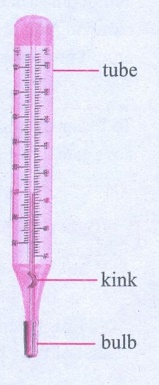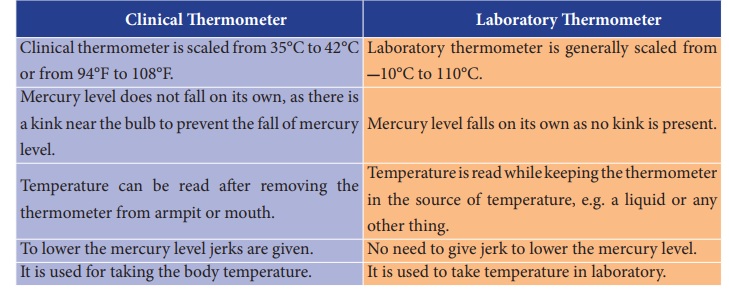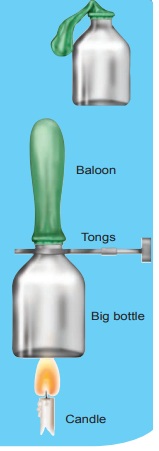Science : Term 2 Unit 1 : Heat and Temperature
EVALUATION
I. Choose the correct answer
1. International unit of measuring temperature is . ______________
a. Kelvin
b. Fahrenheit
c. Celsius
d. Joule
Answer: a) Kelvin
2. In thermometer when bulb comes in contact with hot object, liquid inside it
a. expands
b. contracts
c. remains same
d. none of above
Answer: a. expands
3. The body temperature of a healthy man is;
a. 0°C
b. 37°C
c. 98°C
d. 100°C
Answer: b. 37°C
4. Mercury is often used in laboratory thermometers because it______________
a. is a harmless liquid
b. is silvery in colour and is attractive in appearance
c. Expands uniformly
d. is a low cost liquid
Answer: c. expands uniformly
5. Which of the following temperature conversions is incorrect
K ( Kelvin) = °C ( Celsius) + 273.15
°C K
a. -273.15 0
b. -123. +150.15
c. + 127. + 400.15
d. + 450 + 733.15
Answer: d. +450 = +733.15
II. Fill in the blanks
1. Doctor uses clinical thermometer to measure the human body temperature.
2. At room temperature Mercury is in liquid state.
3. Heat energy transfer from hot to cold
4. -7°C temperature is less than 0°C temperature.
5. The common laboratory thermometer is a Celsius scale thermometer
III. Match the following
i. Clinical thermometer – A form of energy
ii. Normal temperature human body – 100°C of
iii. Heat – 37°C
iv. Boiling point of water – 0°C
v. Melting point of water – Kink
Answer :
i) Clinical thermometer – Kink
ii) Normal temperature of human body – 37°C
iii) Heat – A form of energy
iv) Boiling point of water – 100°C
v) Melting point of water – 0°C
IV. Give very short answer
1. Temperature of Srinagar (J&K) is 4°C and in Kodaikanal is 3°C which of them has greater temperature ? What is the difference between the temperatures of these two places?
Kodaikanal has a higher temperature than Srinagar. The temperature difference is 7°C.
2. Jyothi was prepared to measure the temperature of hot water with a clinical thermometer. Is it right or wrong? Why?
A clinical thermometer can be used only to measure body temperature. It is scaled from 35°C to 42°C only. So it cannot be used to measure the temperature of hot water because the temperature of hot water will exceed 42°C. It is wrong to make such an attempt because the greater expansion of mercury will cause the bulb to break.
3. A clinical thermometer is not used to measure the temperature of air, why?
A clinical thermometer is scaled from 35°C to 42°C only. Its bulb should be completely covered by the part of the body such as a patient’s armpit or under the tongue. So it cannot be used to measure the temperature of air.
4. What is the use of kink in clinical thermometer?
The kink prevents the mercury from flowing back into the bulb when the thermometer is taken out of the patient’s mouth. Therefore we can measure the temperature conveniently.
5. Why do we jerk a clinical thermometer before we measure the body temperature?
The mercury level in a clinical thermometer will remain in the same high level even when it is taken out of the patient’s mouth. So we jerk the clinical thermometer to bring the level of mercury down.
V. Give short Answer
1. Why do we use Mercury in thermometers? Can water be used instead of mercury? What are the problems in using it?
1. The expansion of mercury is uniform.
2. Mercury is opaque and shining.
3. Mercury does not stick to the side of the glass.
4. It is a good conductor of heat.
5. As it has highest boiling point and a low melting point a wide range of temperatures can be measured using mercury.
6. Mercury remains in liquid form.
7. Even a small change in temperature causes visible expansion in it.
Water cannot be used in a thermometer. The Relative Density of mercury is 13.6 where as the R.D of water is just 1. So if we use water in a thermometer the length of the thermometer tube should be 13.6 times longer. It is not practicable. So we cannot use water in a thermometer.
2. Swathi kept a laboratory thermometer in hot water for some time and took it out to read the temperature. Ramani said it was a wrong way of measuring temperature. Do you agree with Ramani? Explain your answer.
Yes, I agree with Ramani. The laboratory thermometer has no kink in it. So when we take it out of the hot water the mercury level will drop down immediately. So the laboratory thermometer should not be taken out of the hot liquid while we note the reading.
3. The body temperature of Srinath is 99°F. Is he suffering from fever? If so, why?
No, Srinath doesn’t have a fever. The normal body temperature is 98.6°F. Srinath’s body temperature is just 99°F. This slight difference cannot be considered as fever because body temperature varies slightly from person to person.
VI. Give long answer
1. Draw the diagram of a clinical thermometer and label its parts.

A clinical thermometer is a glass tube with a capillary tube at the centre. It is connected to a bulb with mercury. Mercury can rise or fall along the graduated capillary tube. All clinical thermometers have a kink that prevents the mercury from flowing back into the bulb when the thermometer is taken out of the patient’s mouth, so that the temperature can be noted conveniently. There are temperature scales on either side of the mercury thread, one in Celsius scale and the other in Fahrenheit scale. Since the Fahrenheit scale is more sensitive than the Celsius scale, body temperature is measured in °F only. A clinical thermometer indicates temperatures from a minimum of 35°C or 94°F to a maximum of 42°C or 108°F.
2. State the similarities and differences between the laboratory thermometer and the clinical thermometer.
Difference between clinical and laboratory thermometer
Both the thermometers have a bulb and a stem. Mercury is used in both of them. These are the similarities. The differences are tabulated below.

Clinical Thermometer
1. It is used for taking the body temperature.
2. Clinical thermometer is scaled from 35°C to 42°C or from 94°F to 108°F.
3. Mercury level does not fall on its own, as there is a kink near the bulb to prevent the fall of mercury level.
4. Temperature can be read after removing the thermometer from armpit or mouth.
5. To lower the mercury level jerks are given.
Laboratory Thermometer
1. It is used to take temperature in laboratory.
2. Laboratory thermometer is generally scaled from -10°C to 110°C.
3. Mercury level falls on its own as no kink is present.
4. Temperature is read while keeping the thermometer in the source of temperature, e.g. a liquid or any other thing.
5. No need to give jerk to lower the mercury level.
VII. Higher Order Thinking questions
1. What must be the temperature in Fahrenheit, so that it will be twice its value in Celsius?
-24.61°F temperature is the Fahrenheit scale reading equal to twice that of the Celsius value.
2. Go to a veterinary doctor (a doctor who treats animals). Discuss and find out the normal temperature of domestic animals and birds.
The normal temperature of birds and animals are given below:
Birds have higher body temperature and much higher metabolism than human beings. So, normal body temperature of birds are 40 degree Celsius or 105 degree Fahrenheit which varies in different species of birds.
Body temperatures of domestic animals such as Cattle, Buffalo, Cow, Sheep, Goat, Donkey, Horse, Pig, Dog and Chicken falls in the range of 38 to 42 degree Celsius (or 100.4 to 107.6 degree Fahrenheit).
Numerical Problems
Solved examples
1. How much will the temperature of 68°F be in Celsius and Kelvin?
Given :
Temperature in Fahrenheit =F=68°F
Temperature in Celsius =C=?
Temperature in Kelvin =K=?
(F-32) /9 = C/5
(68-32) / 9 = C/5
C = 5 × 36/9 = 20°C
K = C + 273.15 = 20 + 273.15 = 293.15
Thus, the temperature in Celsius = 20ºC and in Kelvin = 293.15 K
2. At what temperature will its value be same in Celsius and in Fahrenheit?
Given : If the temperature in Celsius is C, thenthe temperature in Fahrenheit (F) will be same,
i.e. F = C.
(F-32)/9= C/5
(or)
(C-32) / 9 = C / 5
(C-32) × 5 = C x 9
5C 160 = 9C
4 C = 160
C = F = 40
The temperatures in Celsius and in Fahrenheit will be same at – 40
3. Convert the given temperature :
1. 45°C = 113 °F
2. 20°C = 68 °F
3. 68°F = 292.15 K = 20 °F
4) 185°F = 85 °C
5. 0°C = 273.15 K
6. -20°C = 253.15 K
7. 100K = -173.15 °C
8) 272.15 K = -1 °C
Student Activities
ACTIVITY 1
What is required?
A small glass bottle, a rubber cork, an empty refill, water, colour, a candle, a fork, a paper.

What to do?
• Take a small glass bottle. Fill it with coloured water.
• Make hole at the centre of the rubber cork.
• Pass empty refill from the hole of the rubber cork.
• Make the bottle air tight and observe the water raised in the refill.
• Make a scale on paper, place it behind the refill and note down the position of the surface of water.
• Hold bottle with fork and supply heat to it with candle. Then observe.
What is the change in the surface of water?
The surface of water level rises up.
• Stop the supply of heat. When water is cooled, observe the surface of water in the refill, what change takes place? Why?
The surface of water level goes down because water contracts when it is cooled.
When, a liquid is heated, it expands and when it is cooled down, it contracts.
ACTIVITY 2
What is required?
A big bottle, a balloon, threads, candle, water, fork

What to do?
• Take one big bottle, and fill some water in it.
• Attach one balloon on the mouth of bottle and fix it with thread.
• Hold bottle with a fork. Heat the bottle with a candle and take observation.
• What change occurs in the state of balloon after heating the bottle?
The balloon expands and becomes erect and swollen.
• What change occurs in the state of balloon after heating the bottle?
Why?
Because the air in the bottle expands due to heat.
Now, let the bottle get cooled down.
What change occurs in the state of balloon after bottle gets cool down? Why?
The balloon shrinks in size and folds down.
When gases substance gets heat, it expands; when it cools it contracts. Why does a tyre get burst in summer?
As it is very hot in summer the air in the tyre expands greatly. The pressure created by the expanded air causes the tyre to burst.
ACTIVITY 3
Measure your body temperature
Wash the thermometer preferably with an antiseptic solution. Hold it firmly by the end and give it a few jerks. These jerks will bring the level of Mercury down. Ensure that it falls below 35°C (95°F). Now place the thermometer under your tongue or arm pit.
After one minute, take the thermometer out and note the reading. It tells you your body temperature. What did you record as your body temperature? 98.6°F
ACTIVITY 4
Use of Laboratory thermometer
* Take some water in a beaker.
* Take a laboratory thermometer and immerse its bulb end in water; holding it vertically. Ensure to dip whole portion of bulb end. The bulb end should not touch the bottom or side of the beaker.
* Observe the movement of rise of mercury. When it becomes stable, take the reading of the thermometer.
* Repeat this with hot water and take the reading.
(i) The reading of mercury level in ordinary water 35°c
(ii) The reading of mercury level in hot water 75°c
ACTIVITY 5
Use of Digital thermometer

1. Wash the tip with warm (not hot), soapy water.
2. Press the “ON” button.
3. Insert the tip of the thermometer into the mouth, bottom, or under the armpit.
4. Hold the thermometer in place until it beeps (about 30 seconds).
Read the display.
5. Turn off the thermometer, rinse under water, and put it away in a safe place.
Maximum _ minimum the rmometer
The maximum and minimum temperatures of the previous day reported in weather reports are measured by a thermometer called the maximum – minimum thermometer.
Most of the people in the world use the Celsius scale to measure temperature for day to day purpose. The Kelvin scale has been designed in such a way, it is not only an absolute temperature scale, but also 1°C change is equal to a 1K change. This makes the conversion from Celsius to absolute temperature scale (Kelvin scale) easy, just the addition or subtraction of a constant 273.15
But in United States they prefer to use the Fahrenheit scale. The problem is, converting Fahrenheit to absolute scale (Kelvin) is not easy.
To sort out this problem they use The Rankine scale. It named after the Glasgow University engineer and physicist Rankine, who proposed it in 1859. It is an absolute temperature scale, and has the property of having a 1°R change is equal to a 1°F change. Fahrenheit users who need to work with absolute temperature can be converted to Rankine by
R= F+ 459.67














